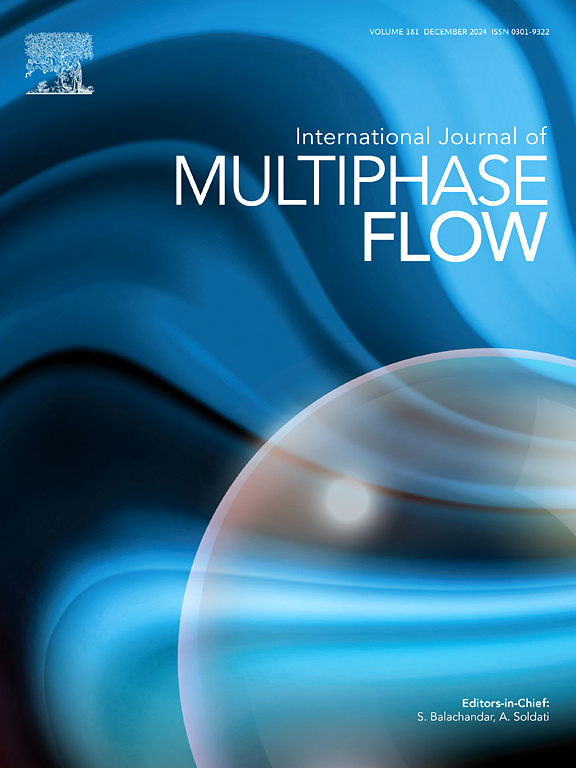On the interaction of a cavitation bubble with an carbon fiber composite elastic plate
IF 3.6
2区 工程技术
Q1 MECHANICS
International Journal of Multiphase Flow
Pub Date : 2025-03-20
DOI:10.1016/j.ijmultiphaseflow.2025.105203
引用次数: 0
Abstract
We experimentally and numerically investigated the interaction between a spark-induced bubble and an elastic plate. We focused on the bubble dynamics and plate deformation, which influenced by different boundary thickness h ( h ) and initial stand-off distance (). The elastic plate is made of carbon fiber layers, attached to a gum base of 0.1 mm thickness. A transient cavitation bubble generated by the fast electric discharge between two immersed electrodes, and the bubble maximum radius is 20 mm. We used high-speed camera to capture the bubble motion and the boundary motion at the simultaneously. We also conducted numerical simulations with the immersed boundary method, taking into account fluid compressibility and the boundary motion. The research results demonstrate that the amplitude of plate deformation directly affects the dynamic behavior of the bubble. The plate deformation along vertical direction is periodic in time, and the difference between the free end and the center () is almost an approximate wave function. A dimensionless parameter is proposed to measure the frequency and amplitude of boundary oscillations. The trend of over time satisfies the wave equation, which shows that the plate undergoes a similar harmonic vibration after the force is applied. The function can be viewed as a superposition of an external force (from the flow field) induced oscillation () and a self-inertial oscillation (). We found that increasing the initial distance mainly reduces the maximum amplitude of the external force-induced oscillation . Increasing the plate thickness h results in a reduction of both the frequency and amplitude of the oscillation function. Some of the conclusions of this work can be applied to the design of new hydromechanics of materials.
空化气泡与碳纤维复合材料弹性板的相互作用
实验和数值研究了火花诱导气泡与弹性板之间的相互作用。重点研究了不同边界厚度h (0.5<;H <2.0mm)和初始隔离距离γ (0.5<γ<2.0)。弹性板由碳纤维层制成,附着在0.1毫米厚度的胶基上。两个浸没电极之间快速放电产生的瞬态空化气泡,气泡最大半径为20mm。我们使用高速摄像机同时捕捉气泡运动和边界运动。考虑流体可压缩性和边界运动,采用浸入边界法进行了数值模拟。研究结果表明,板的变形幅度直接影响气泡的动力特性。板沿垂直方向的变形在时间上是周期性的,自由端与中心之间的差(λ)几乎是近似的波函数。提出了一种测量边界振荡频率和振幅的无量纲参数Δζ。Δζ(t)随时间的变化趋势满足波动方程,说明受力后板发生了类似的简谐振动。该函数可以看作是外力(来自流场)诱导振荡(ζ1)和自惯性振荡(ζ2)的叠加。我们发现,增加初始距离γ主要降低了外力诱导振荡的最大振幅ζ1。增加板厚h会导致振荡函数的频率和振幅的减小。本工作的一些结论可以应用于新型材料流体力学的设计。
本文章由计算机程序翻译,如有差异,请以英文原文为准。
求助全文
约1分钟内获得全文
求助全文
来源期刊
CiteScore
7.30
自引率
10.50%
发文量
244
审稿时长
4 months
期刊介绍:
The International Journal of Multiphase Flow publishes analytical, numerical and experimental articles of lasting interest. The scope of the journal includes all aspects of mass, momentum and energy exchange phenomena among different phases such as occur in disperse flows, gas–liquid and liquid–liquid flows, flows in porous media, boiling, granular flows and others.
The journal publishes full papers, brief communications and conference announcements.

 求助内容:
求助内容: 应助结果提醒方式:
应助结果提醒方式:


